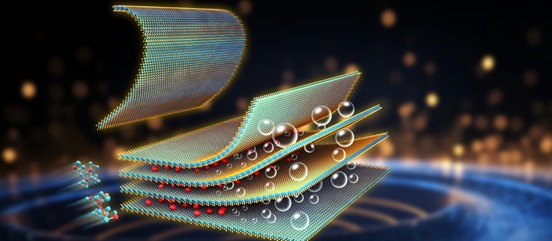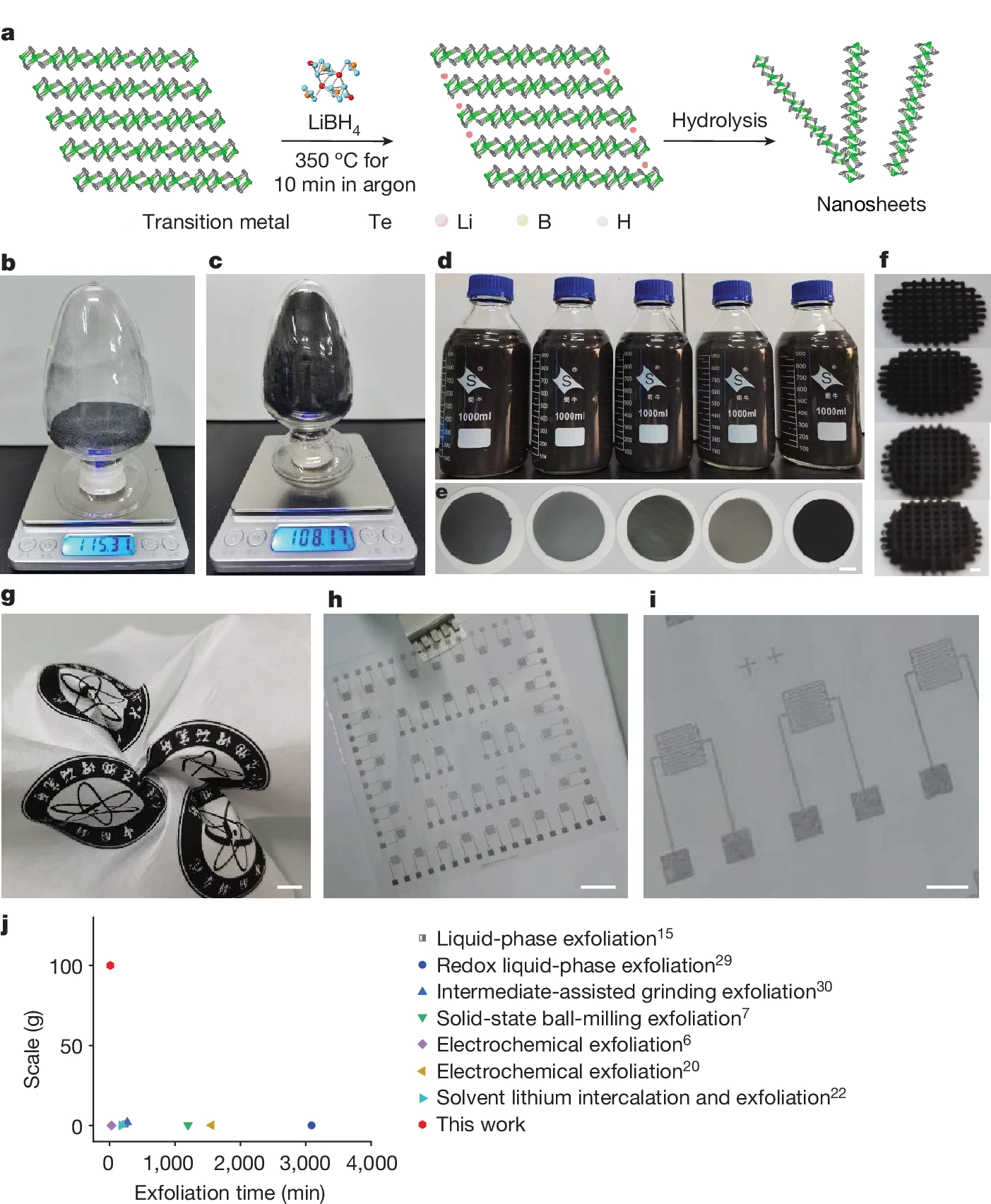
On April 3, 2024, our research work entitled "Metal telluride nanosheets by scalable solid lithiation and exfoliation" has been published online in Nature, achieved jointly by the team from Prof. Zhong-Shuai Wu (@DICP), A. P. Ning Kang (Peking Univ.) and Prof. Hui-Ming Cheng (IMR & SIAT, CAS; SUAT, Shenzhen). At the same time, Nature also reported on this research achievement in the "Nature Briefing" column under the title "Scalable, high-quality 2D telluride nanosheets for energy and catalysis applications". This study reported the fast and scalable synthesis of a wide variety of MTe2 (M = Nb, Mo, W, Ta, Ti) nanosheets by the solid lithiation of bulk MTe2 within 10 min and their subsequent hydrolysis within seconds. This research opens new opportunities for the universal and scalable synthesis of transition metal tellurides (TMTs) nanosheets for exploring new quantum phenomena, potential applications, and commercialization.
TMTs have been investigated less thoroughly than other 2D materials despite being some of the most fascinating materials for both fundamental research and industrial applications. Several TMTs, such as WTe2 and MoTe2, have been recently investigated for a variety of quantum phenomena, including an extremely large magnetoresistance, topologically nontrivial phases, coupled ferroelectricity and superconductivity.
Currently, the "top-down" approach is commonly used for large-scale production of nanosheets. However, this method encounters various issues when preparing TMT nanosheets, including high intercalation reaction energy barriers, inefficient intercalation reactions, low exfoliation efficiency, and poor safety. For instance, nanosheets prepared by mechanical milling and liquid-phase exfoliation exhibit submicron lateral dimensions and poor repeatability, limiting their application due to overall low quality. Electrochemical intercalation exfoliation requires electrodes to be prepared as large single crystals or layer materials scraped onto conductive substrates, making large-scale preparation difficult. Chemical intercalation exfoliation involves the use of organic lithium as an intercalation agent, but organic lithium is highly flammable and explosive, requiring operation under negative pressure or in glove boxes, which imposes high requirements on experimental equipment and is unsafe. Therefore, developing safe, reproducible, and scalable synthesis techniques is the technical bottleneck for the practical application of TMT nanosheets beyond the laboratory.

In this work, our group proposed a novel solid-phase chemical intercalation exfoliation method. By lowering the activation energy of the intercalation reaction through high-temperature solid-phase reactions, they innovatively screened a solid-phase intercalation reagent, i.e., lithium borohydride. Lithium borohydride, known for its strong reducing properties and stability in dry air, was used to achieve high-temperature solid-phase lithium intercalation reactions, overcoming the slow intercalation reaction rate and thereby realizing safe, efficient, and rapid intercalation exfoliation. The entire intercalation exfoliation process only takes a short 10 min, enabling the macroscopic preparation of hundreds of grams (108 g) of NbTe2 nanosheets, which is two orders of magnitude larger than previous research preparations, typically less than 1 gram. Importantly, this method is universal. It successfully prepared nanosheets of five different transition metal tellurides (MoTe2、WTe2、NbTe2、TaTe2 and TiTe2) and twelve alloy compounds, enriching the library of two-dimensional materials and achieving material functionalization and customized preparation. Additionally, the team observed various intriguing quantum phenomena. For example, MoTe2 nanosheets exhibited a thickness-dependent metal-insulator transition, while WTe2 nanosheets showed giant magnetoresistance and the Shubnikov-de Haas effect.
A series of two-dimensional metal telluride and alloy compound nanosheets prepared in this work are expected to provide a new platform material system for research in energy chemistry, materials science, condensed matter physics, and other fields. It is worth noting that two-dimensional TMT nanosheets exhibit excellent processability and can be further processed into solutions, thin films, screen printing inks, 3D printed devices, and micro supercapacitors. Our group further verified the important application potential of such two-dimensional materials in high-performance quantum devices, micro-supercapacitors, advanced batteries, energy catalysis, electromagnetic shielding, composite materials, and other fields.
The co-first authors of this work are Dr. Liangzhu Zhang from our group (already completed his postdoctoral research) and graduate student Zixuan Yang from Peking University. The spherical aberration-corrected transmission electron microscopy characterization part of this achievement received support from Prof. Mingrun Li in our SKLC. The aforementioned work was funded by the National Natural Science Foundation of China, the National Natural Science Foundation of China's "Six-Membered Ring Inorganic Materials" Basic Science Center Project, the National Key Research and Development Program, the National Postdoctoral International Exchange Program, the China Postdoctoral Science Foundation, the Shanghai Pujiang Talent Program, and other projects.
Publicly share full-text access:: https://rdcu.be/dDx2n